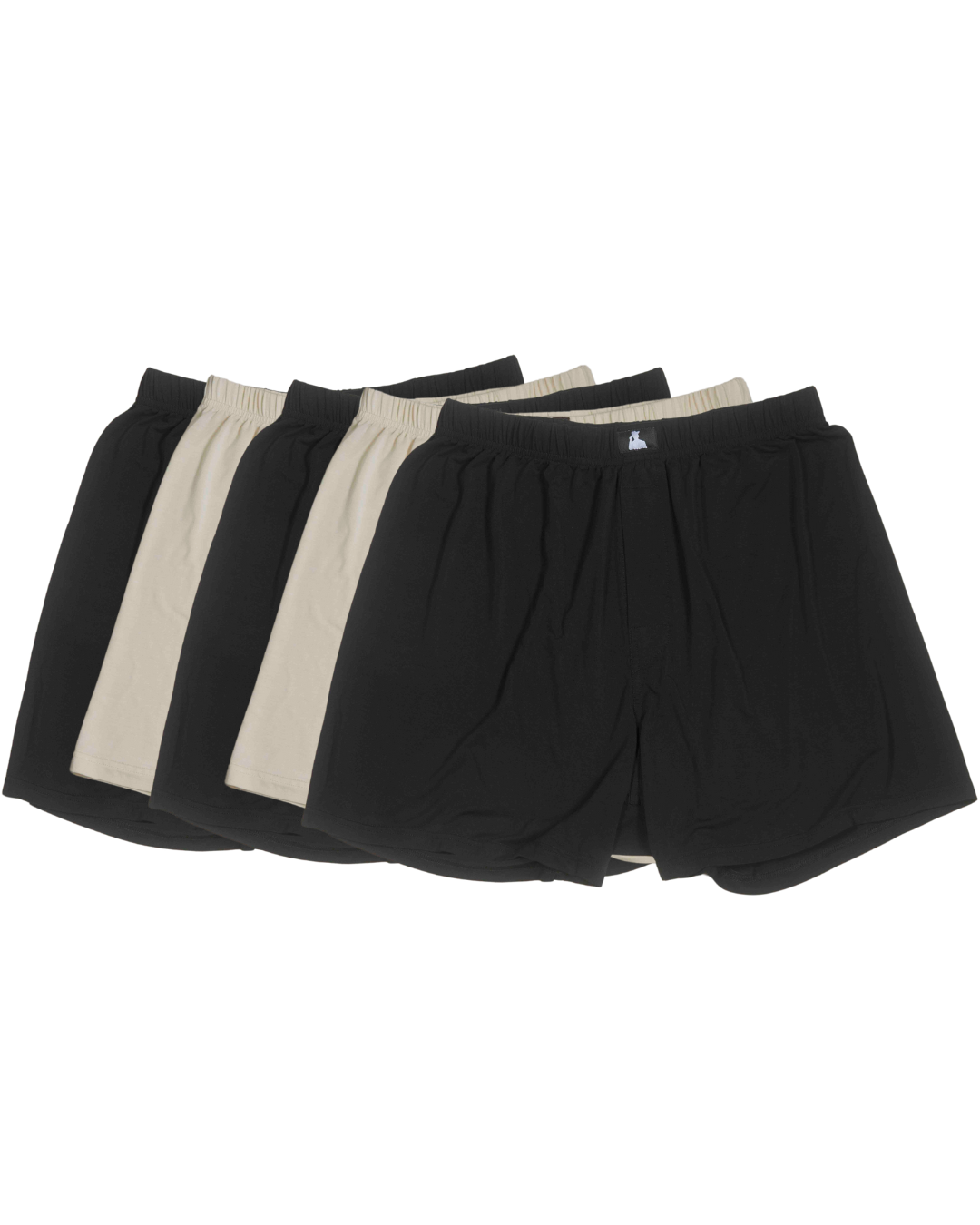Why Non-Toxic Underwear Is Becoming a Must for Men’s Reproductive Health
Written By The Mr. Fertyl Research & Education Team
The New Focus on Fertility and Underwear
Male reproductive health is getting more attention than ever – and for good reason. Research suggests environmental factors like hormone-disrupting chemicals and excess heat can negatively impact sperm quality [1]. Sperm counts worldwide have shown significant declines over the past decades, and endocrine disruptors (chemicals that interfere with hormones) are suspected culprits [1]. With fertility challenges on the rise, more men are looking for everyday ways to protect their reproductive health. One surprisingly important change is switching to non-toxic underwear. It turns out that the fabric you wear all day, right next to some of your most sensitive organs, can have a real impact on your fertility and overall health.
The idea might sound far-fetched at first – how much could your boxers or briefs really matter? But consider this: your groin area isn’t just another patch of skin. The scrotum (the skin that holds the testicles) is highly absorptive and sensitive. In fact, studies have found that the scrotal skin absorbs substances faster than almost any other area of the body [2]. That means any chemicals in your underwear fabric have an easy pathway into your body. At the same time, testicles are designed to stay slightly cooler than the rest of your body for optimal sperm production. Trapping them in the wrong kind of underwear – tight, synthetic, non-breathable – can raise their temperature and slow down sperm generation [4]. These realities are driving a new movement: men seeking out non-toxic, breathable underwear as a simple step to safeguard fertility.
What’s Hiding in Your Underwear? (And Why It’s Risky)
You might assume all clothing is safe – after all, if it’s sold in stores it must be fine, right? Unfortunately, conventional underwear (especially those made of synthetic materials or non-organic cotton) can contain a cocktail of chemicals. Manufacturers often add or leave residual chemicals in fabrics for various reasons (dyeing, finishing, making clothes wrinkle-free, etc.). Here are some common offenders found in men’s underwear fabrics and why they could pose a risk:
- Formaldehyde: Often used to give clothes “wrinkle-free” or anti-odor properties. Formaldehyde is a known irritant and even a probable carcinogen. More concerning for our purposes, high exposure to formaldehyde has been linked to fertility problems and miscarriage [3]. It’s not something you want touching your skin – especially not daily near your reproductive organs.
- Azo Dyes: These synthetic dyes create vivid colors in fabrics. The downside is that certain azo dyes can break down into aromatic amines, chemicals known to be carcinogenic. They have been restricted or banned in some countries, but trace amounts still appear in cheaply dyed textiles. When you sweat, these dye compounds can leach out and be absorbed through the skin.
- Phthalates: Phthalates are plasticizing chemicals used to make materials soft and flexible. They might be present in the elastic waistbands, prints, or even in the fabric of underwear made with polyester or blends. Phthalates are well-known endocrine disruptors – they interfere with hormone production, including lowering testosterone levels [6]. Lower testosterone in turn can impair sperm production. In short, phthalates have been associated with reproductive harm in men, and you don’t want them seeping into your body from your undergarments.
Other potential chemicals: This is just the beginning. Conventional cotton is heavily treated with pesticides during cultivation, and those residues can linger in fabric. Laundry-resistant nonylphenol ethoxylates (NPEs) used in textile processing break down into nonylphenol, a hormone disruptor tied to reproductive system problems. Some performance or stain-resistant underwear may even contain PFAS (“forever chemicals”) to repel water or odors; these have been linked to issues like cancer and infertility. In essence, a lot of underwear on the market isn’t as “clean” as we’d hope.
Why do these hidden chemicals matter? Because when you wear that underwear, you’re effectively pressing these substances against one of the most absorptive parts of your body all day long. Your skin can absorb many chemicals, and as noted, scrotal skin is especially permeable [2]. Over time, that chronic low-dose exposure can add up. Experts warn that prolonged contact with such toxins may contribute to hormone imbalances or fertility challenges down the road. In other words, the wrong underwear might slowly be chipping away at your reproductive health without you even realizing it.

Tired of Toxins Near Your Most Vital Parts? Try Non-Toxic Men’s Underwear
Protect Your Fertility TodayOrganic Cotton Is Good – But Is It Good Enough?
If you’ve already switched to organic cotton boxers, you’re on the right track. Organic cotton means the fiber was grown without toxic pesticides or synthetic fertilizers, eliminating a major source of chemicals. This is certainly a big improvement over conventional cotton. However, it’s important to understand that “organic cotton” doesn’t automatically equal “chemical-free underwear.” It refers to how the cotton was grown, but what happens after harvest also matters. Many organic cotton underwear products are still processed and dyed with conventional chemicals unless they have additional certifications.
For example, an organic cotton brief could be treated with colorants or finishing agents that include some of the nasties we mentioned (dyes, bleaches, even formaldehyde-based finishes for wrinkle resistance). Unless the garment is certified by standards like GOTS or OEKO-TEX® that limit chemical use, residues can remain in the fabric. In fact, experts advise looking beyond just the fiber and checking for certifications. As one sustainable fashion guideline notes: if a label boasts being “wrinkle-free” or “stain-resistant,” that’s a red flag that chemical treatments were involved.
The point here is not to scare you away from organic cotton – it’s still one of the best natural options out there, especially when properly processed. Just remember that organic cotton underwear isn’t magically exempt from all factory chemicals. It’s wise to wash any new organic undies before the first wear, and whenever possible, choose brands that also ensure non-toxic processing (dyes, finishes, etc.). Organic + Non-Toxic is the ideal combo. If that sounds hard to find, don’t worry – in the next section, we’ll introduce another fabric that checks all those boxes and more.
Sensitive Skin, Endocrine Disruption, and the Scrotum
Let’s talk a bit more about why the groin area is so sensitive and how exactly toxic fabrics could affect male fertility. The skin around the scrotum and inner thighs is thinner and has a rich supply of blood vessels close to the surface. This is by design – the testicles need to maintain a cooler temperature for sperm production, so the skin there is optimized for heat exchange (hence its looseness and sweat glands). Unfortunately, this also means chemicals placed there get easy access to your bloodstream [2]. You could almost view the scrotum as a direct pipeline for whatever you put on it – which is why medicated creams (like testosterone gels) are sometimes applied to that area for fast absorption.
Now consider the nature of many chemicals we discussed. Phthalates, BPA, nonylphenols… these are classified as endocrine disrupting chemicals (EDCs). They have the ability to mess with your hormones – the body’s chemical messengers. In men, EDCs are particularly notorious for lowering testosterone and impairing sperm parameters [1][6]. For instance, phthalates have been shown to reduce androgen (testosterone) levels and have been linked to lower sperm counts in research [1][6]. It doesn’t happen overnight, but chronic exposure matters. If your hormone balance is thrown off by daily EDC exposure, the cumulative effect could be fewer sperm being produced or sperm that don’t swim as well.
Moreover, heat and humidity compound the issue. Tight, non-breathable underwear made of polyester or nylon can raise the temperature of the testes and also cause sweating without proper evaporation. Sperm are quite sensitive to heat – they thrive a few degrees below core body temperature, which is why testicles hang outside the body. When the scrotum is consistently warmer (even by 1°C), sperm production can slow and DNA damage in sperm can increase [7][9]. One famous study even tested polyester underwear as a form of male birth control. The result? Men who wore a polyester sling around their scrotum became azoospermic – meaning their sperm count dropped effectively to zero – after some months of continuous wear [5]. (Thankfully, it was reversible once they stopped wearing it, but it proves the point: fabric and heat matter for fertility.) Even aside from extreme cases, doctors often advise men trying to conceive to choose loose boxers over tight briefs to maximize airflow and keep the scrotum cool[9].
The groin area is also prone to skin irritation since it’s often warm and moist – a perfect environment for rashes or infections if the fabric doesn’t breathe. Any toxic residues in that fabric might trigger contact dermatitis or irritation in some men (think redness, itching in the groin that you might have blamed on sweat alone). All these factors illustrate why choosing underwear made from clean, breathable materials is more than a comfort issue – it’s a real health consideration.
Enter Bamboo Lyocell: A Fertility-Friendly Alternative
So, what should a health-conscious guy look for in underwear? The ideal fabric for men’s underwear would be: non-toxic, breathable, moisture-wicking, temperature-regulating, and gentle on skin. Bamboo Lyocell happens to check all of those boxes, which is why it’s quickly gaining popularity as a fertility-safe choice for men’s undergarments.
What is Bamboo Lyocell? It’s a fabric made from bamboo pulp through a modern “closed-loop” process. Without getting too technical, the bamboo is broken down with a non-toxic solvent in a way that the solvent is recycled in the factory (hence closed-loop). This process avoids harsh chemicals like the sulfuric acid and carbon disulfide used in traditional rayon/viscose manufacturing. The result is a clean, silky fiber. Importantly, because of this clean production, bamboo lyocell fabrics often pass stringent safety tests – many are certified under OEKO-TEX® Standard 100, meaning they contain no harmful residues that could transfer to your skin. In other words, you’re not going to find formaldehyde, heavy metals, or phthalates lurking in genuine bamboo lyocell underwear.
Breathability and moisture control: Bamboo lyocell is superbly breathable and moisture-wicking. The fiber structure has micro-gaps that allow for better ventilation and absorbency than cotton [8]. This means sweat is quickly pulled away from your skin and evaporates, keeping your groin drier and cooler. In hot weather, a bamboo fabric brief won’t stick to your skin or cause that swampy feeling; it helps you stay cool and comfortable. In fact, bamboo fabric is often praised for its thermo-regulating property – keeping you cooler in summer and also comfortably warm in winter[8]. For male fertility, this breathability is a huge plus: it helps prevent overheating of the testicles and maintains an optimal environment for sperm production.
Softness and sensitivity: Bamboo lyocell is extremely soft (often compared to silk or cashmere in feel [8]) and naturally hypoallergenic. If you have sensitive skin or have ever experienced irritation from synthetic underwear, bamboo fabric can be a game-changer. It lacks the chemical finishes that often cause skin reactions. And because bamboo has natural antibacterial properties, it resists odors and bacterial growth without requiring chemical antimicrobial treatments[8]. That means fewer additives and also less risk of infections or jock itch in a region that benefits from cleanliness. In short, it’s kind to your skin and by extension, kind to your reproductive organs.
You might be wondering: if bamboo lyocell is so great, why don’t we see “GOTS organic” certification on it? The answer is simply a quirk of textile labeling – GOTS (Global Organic Textile Standard) primarily certifies naturally grown fibers like cotton or wool. Since bamboo undergoes a man-made process to become lyocell fiber, it isn’t classified as “organic” under GOTS criteria. In fact, the GOTS authority hasn’t certified any bamboo textile as organic, not because bamboo lyocell is unsafe, but because of how the standard is defined. The key thing to know is that bamboo lyocell doesn’t need to be “organic” to be safe. Its manufacturing is eco-friendly and the end product is toxin-free (look for OEKO-TEX or similar safety certs as reassurance). So don’t be deterred if you don’t see an organic label on bamboo underwear – the material is still one of the healthiest you can choose for fertility.
Why We Chose Bamboo Lyocell (Our Fertility-First Philosophy)
At this point, it’s clear that non-toxic, breathable underwear is more than just a trend – it’s becoming a must for men who care about their reproductive health. This belief is at the core of our brand’s mission. We’re a fertility-first company, meaning we put male reproductive wellness at the forefront of every decision. That’s exactly why we chose bamboo lyocell as the foundation for our men’s underwear line.
Our goal was to eliminate the hidden hazards (chemicals, excessive heat, irritation) that can come with ordinary underwear. Bamboo lyocell aligns with that goal perfectly:
- No Harmful Chemicals: From the start, we wanted a fabric that we could guarantee was toxin-free. Bamboo lyocell gave us that peace of mind – its closed-loop production and OEKO-TEX® certifications ensure our boxers have zero formaldehyde, azo dye residues, phthalates, or any other questionable substances. You can wear them knowing nothing sketchy is touching your skin. Keeping endocrine disruptors away from your groin means one less source of potential hormone interference in your daily life – a win for your testosterone and sperm count.
- Breathability = Cooler Testicles: Our bamboo lyocell underwear lets your body breathe. The fabric’s ability to wick moisture and allow airflow helps maintain a lower temperature around the scrotum. We chose this material because we knew it would help guys avoid the sperm-killing heat buildup that you get with synthetic briefs. It’s all about creating an ideal microclimate for your swimmers. As one slogan puts it, it really is “the underwear your future depends on.” (In this case, future family!)
- Uncompromising Comfort for Sensitive Areas: We also put comfort front and center, because what good is healthy underwear if you don’t want to wear it? Bamboo lyocell is luxuriously soft and smooth, which means no chafing and no irritation. That softness, combined with the fabric’s natural hypoallergenic and antibacterial qualities, keeps your groin skin calm and fresh. Our customers often tell us it’s the most comfortable pair of underwear they’ve owned – and that means they’re likely sticking with it, doing good for their health every single day.
Ultimately, our brand’s ethos is that men shouldn’t have to sacrifice health for comfort (or vice versa). You can have both. By choosing a clean fabric like bamboo lyocell, we’re able to deliver an underwear that supports male fertility while also being extremely comfortable and durable. It’s a core part of how we envision men’s wellness: addressing the often-overlooked factors, like the clothes you wear, with a science-backed, prevention-oriented approach.

The Non-Toxic Men’s Underwear Your Future Family Will Thank You For
Shop Non-Toxic UnderwearBottom Line
Non-toxic underwear is not a gimmick – it’s a smart and proactive measure for protecting your reproductive health. Whether you’re planning to start a family or just want to ensure everything “down there” stays in top shape, consider what your underwear is made of. Ditching the chemical-laden synthetics and switching to a fabric like bamboo lyocell is a simple change that can have meaningful benefits. Your sperm (and your future self) may thank you for it. After all, caring for your fertility isn’t just about doctor visits and diets; it can start with something as basic as the underwear you put on every morning.
- Szalinski, C. (2024). Are Sperm Counts Really Declining? – Scientific American. Endocrine-disrupting chemicals (like phthalates, BPA) have been linked to drops in sperm count; ambient heat also affects sperm count. Source
- National Research Council (US). Strategies to Protect the Health of Deployed U.S. Forces: Hazardous Chemical Exposures. Research showed the scrotum is the highest absorbing skin site, meaning chemicals on scrotal skin are absorbed more readily than elsewhere. Source
- NIOSH, CDC – About Formaldehyde and Reproductive Health (2024). Occupational formaldehyde exposure is known to cause cancer and may increase the chances of fertility problems or miscarriage in men. Source
- WebMD – Keep Your Scrotum Cool (n.d.). Health guidance noting that heat slows down sperm production; men are advised to avoid hot baths, wear boxers instead of briefs, and not wear tight pants to protect fertility. Source
- Feldman & Maibach (1967) – Ultimate Guide to Non-Toxic Clothing (2024). Mentions a study where men wearing a polyester scrotal sling developed azoospermia (no living sperm) – a reversible effect demonstrating polyester’s impact on reproductive health. Source
- Endocrine Society – Common EDCs and Where They Are Found (2021). Phthalates interfere with the production of testosterone (a crucial hormone for male fertility), underscoring why phthalate exposure is concerning for men’s reproductive health. Source
- Mayo Clinic Health System – Boxers or Briefs? Fertility Myths Debunked (2019). Confirms that scrotal temperatures are normally cooler than body temperature and that higher temperatures can reduce male fertility. Tight underwear may slightly raise temperatures, so looser styles are often recommended when trying to conceive. Source
- Natural Life Magazine – Bamboo Textiles: Green, Luxurious and Practical (2009). Describes bamboo fiber’s properties: very breathable, moisture-wicking, fast-drying, and thermal-regulating. Bamboo fabric keeps you drier and cooler, making it ideal for sensitive skin and comfort. Source
- WebMD- Undescended Testicle and Fertility Problems. Source

